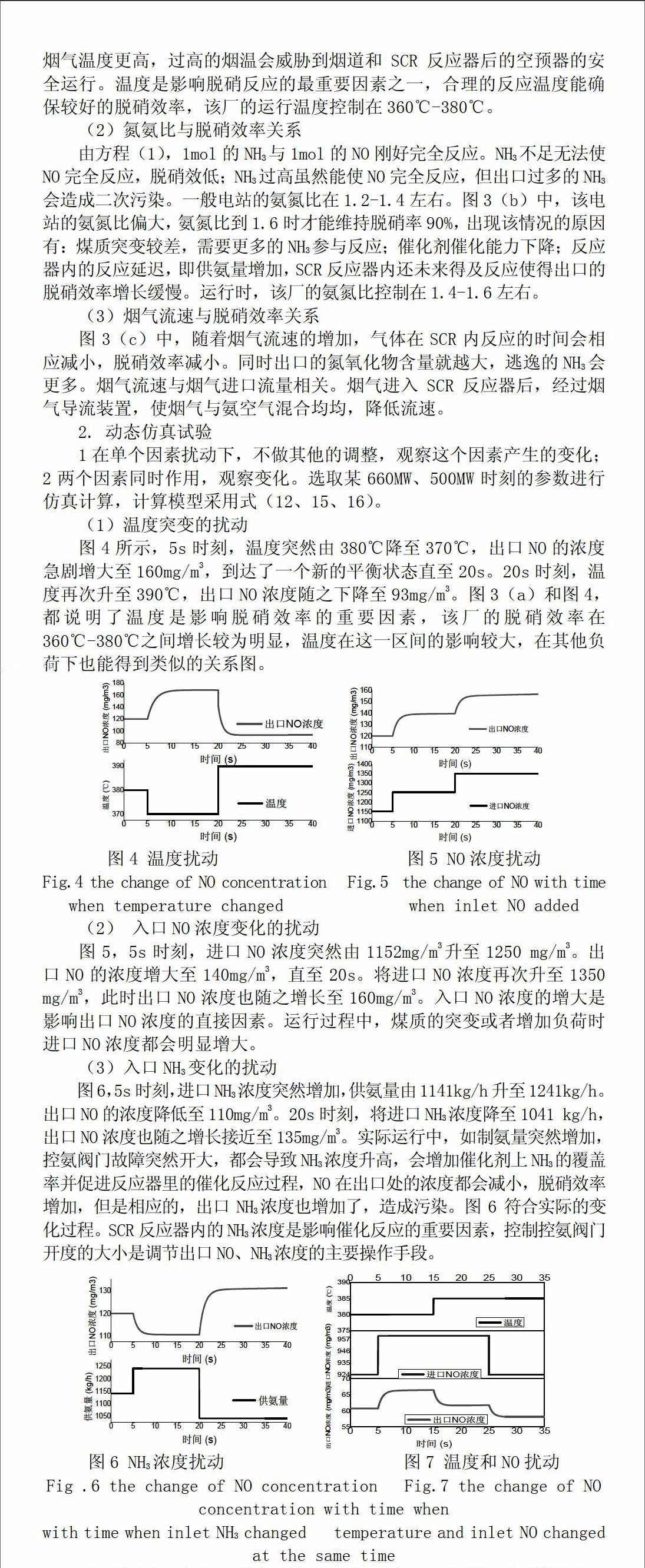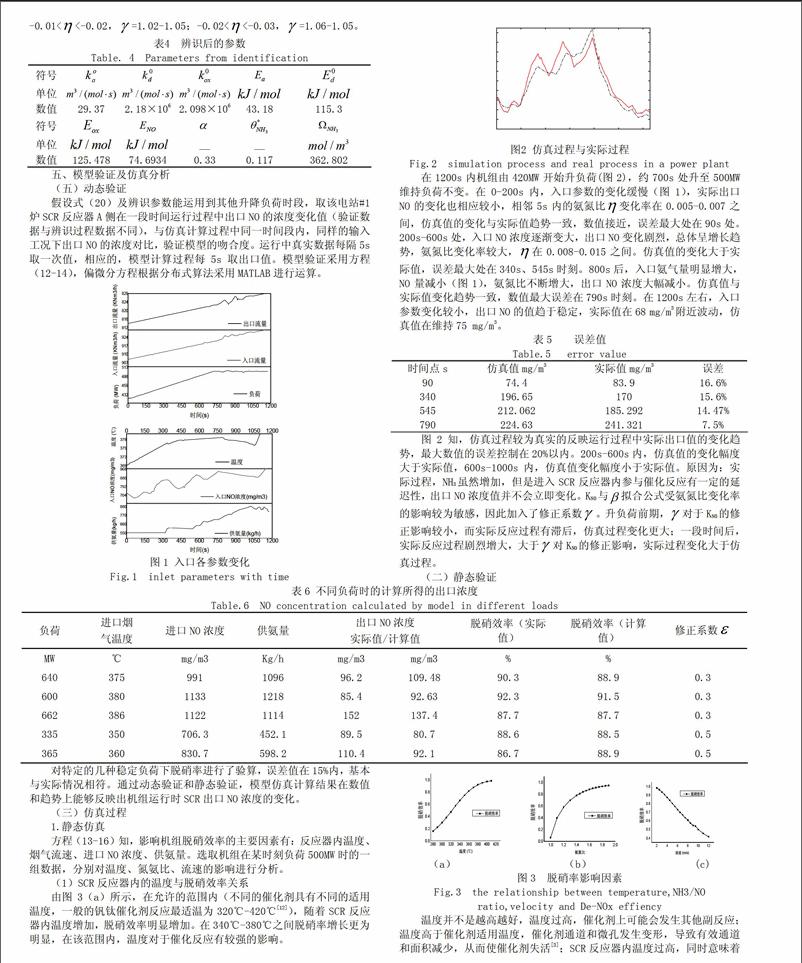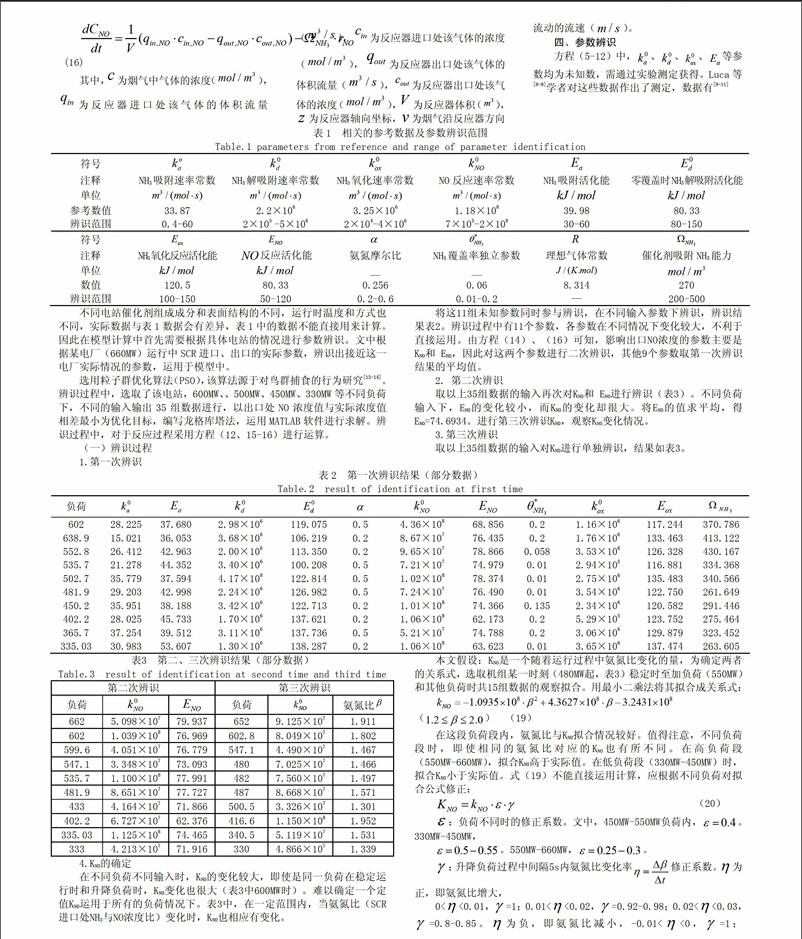火电站烟气脱硝系统建模与仿真
2017-04-21廖立杨鹏志
廖立++杨鹏志



摘 要:SCR脱硝技术是火电站使用的较为成熟的脱硝方法。本文中,以SCR反应器出口NO浓度为研究目标,采用Langmuir吸附层模型和E-R反应机理建立反应模型,运用现场运行数据和辨识技术获得了模型特征参数,并假设NO反应速率指前因子KNO是一个随反应过程氨氮比变化的变量。通过电站实际运行中动态、稳态过程进行验证分析。仿真试验表明:1)辨识参数及对于KNO的的假设具有合理性,模型能够反应运行过程中NO出口浓度变化过程。2)反应温度,进口NO浓度,供氨量、烟气流速对于催化反应有着重要的影响。3)运行过程中,及时控制供氨量、保证氨氮比变化率是防止排放超标的有效手段。
关键词:烟气脱硝;建模与仿真;辨识;电站运行
Modeling and simulation of SCR reaction in a power plant
Liao Li, Yang Pengzhi
Key Laboratory of Low-grade Energy Utilization Technologies and Systems, Chongqing University, Ministry of Education, Chongqing 400044, PR China
Abstract: The SCR (selective catalytic reduction) technique is an advanced way to removal NOx from the flue gases in coal-fired power plants. Based on the Langmuir adsorption-desorption model and Eley-Rideal reaction mechanism, a dynamic mathematical model is established in this paper to focus on the nitrogen monoxide concentration at the outlet of the SCR reactor . In additional, identification technique is applied to obtain the exact value of certain kinetic parameters based on the data from a power plant and the assumption that the pre-exponential factor for the DeNOx reaction KNO is a variable which is affected by the NH3/NO concentration ratio at the inlet of the SCR reactor. The SCR model is tested in static state situation and dynamic state situation in different loads in the power plant .The result of simulation suggests that: A)these parameters gained from identification and the SCR model can suit the real SCR reaction in this power plant .B) Temperature, ammonia concentration, nitrogen monoxide concentration as well as gas velocity play crucial roles in SCR reaction .C)In the power plant, the amount of ammonia supply, the control of NH3/NO concentration ratio are effective methods to ensure the nitrogen monoxide concentration at the outlet of the SCR reactor stays in an appropriate range especially in the load up process or load down process.
Keywords: SCR; modeling and simulation; identification; power plant operation
對于该电厂,相比于温度和进口NO的影响,NH3的增加对于脱硫效率的提高较为缓慢,如图3(b)、图6。表3也可以看出,该厂需要的供氨量也很大,氨氮比偏高,在1.4以上,尤其是在负荷变化时,需要更大的氨量,其氨气逃逸量控制在0.015PPM-0.03PPM左右,符合排放标准。在实际运行中,升降负荷时,需提前增大供氨量,保持氨氮比变化率在0.01以内。并随时监视出口NO和NH3的排放量,防止排放超标(该厂出口浓度大于200mg/m3即为超标排放)。
(4)温度与NO共同扰动
选取机组某500MW时稳定状态时的参数值。 图7中,5s时刻,进口NO浓度突然升高至962mg/m3,出口NO的浓度相应的增大至68mg/m3 。 15s时刻,突然增加进口烟气温度至385℃,催化效应增加,出口NO浓度减小,直至25s处,保持温度385℃,进口NO浓度降至924 mg/m3。此时可见出口NO浓度减小至56 mg/m3。 变化过程和趋势符合实际的变化。
六、结论
1依据Langmuir吸附层模型、E-R反应机理、建立反应器出口NO浓度变化的模型,其中未知参数采用多次辨识的方法获得,假设KNO是一个与氨氮比变化率有关的函数,通过拟合得到关系式 。仿真过程的关键是确定不同阶段的负荷时起始修正系数 ,负荷变化时根据前后时间段氨氮比变化率乘以相应 。模型能够较为真实的反应机组运行时出口NO浓度的变化趋势和相应数值,最大误差控制在25%以内。
2模型验证和仿真过程中,反应温度升高、烟气流速降低有利于催化反应的进行,入口NO浓度降低、供氨量增加亦能减小出口NO排放量。
3模型能够对该电厂的脱硝运行过程进行分析和预测,为运行中提供指导防止排放超标:1)入口NO量(通过煤质、负荷)、反应温度、供氨量的控制是保证脱硝效率的主要手段;2)从仿真试验中,该电厂催化剂在360℃-380℃之间温度的增加使得催化效率能明显提高。运行过程中,机组在550MW-660MW时,将烟气温度控制在375℃-385℃之间。400MW-550MW时,应将烟气温度控制在365-375℃。300MW-400MW时,将烟气温度控制在360℃-365℃;3)控制供氨量是运行中保证出口浓度的最主要手段。升降负荷过程中,进口NO浓度变化较大,出口浓度变化剧烈。加入的NH3反应有滞后性,负荷变化时,应提前增减供氨量。确保前后5s内氨氮比变化率控制在0.01以内,即每分钟供氨量的增减控制在30kg/h以内。
参考文献:
[1] 刘涛.SCR多元催化剂脱硝性能试验研究及数值模拟 [D]. 东南大学硕士学位论文,2006
[2] 孙克勤,钟秦.火电厂烟气脱硝技术及工程应用[M]. 北京:化学工业出版社,2007.10:9.
[3] 段传和,夏怀祥.燃煤电厂SCR烟气脱硝工程技术[M].北京:中国电力出版社,2009.4:19
[4] 朱炳辰.化学反应工程[M]. 北京:化学工业出版社,2006.12:38
[5] Koebel M, Elsener M. Selective catalytic reduction of NO over commercial DeNOx-catalysts Experimental determination of kinetic and thermodynamic parameters [J]. Chemical Engineering Science,1998,53(4):657-669.
[6] 赵宁,沈伯雄,杨晓燕,刘亭. 烟气选择性催化还原脱硝的数值模拟研究进展[J].化工进展,2010,29:2165-2170.
[7] Kijlstra W S,Brands D S,Smit H I,et al. Mechanism of the selective catalytic reduction of NO with NH 3 over MnO x /Al 2 O 3 [J]. Journal of Catalysis,1997,171(1):219-230.
[8] Luca Lietti,Isabella Nova,Enrico Tronconi,Pio Forzatiti.Transient kinetic study of the SCR-DeNOx reaction [J].Catalysis Today,1998(45):85-92.
[9] Isabella Nova, Luca Lietti, Enrico Tronconi, Pio Forzatiti. Dynamics of SCR reaction over a TiO2-supported vanadia-tungsta commercial catalyst [J]. Catalysis Today,2000(60):73-82.
[10] Isabella Nova, Luca Lietti, Enrico Tronconi, Pio Forzatiti .Transient response method applied to the kinetic analysis of the DeNOx-SCR reaction [J].Chemical Engineering Science,2001(56):1229-1237
[11] 俞逾.选择性催化还原系统的建模与仿真[D].重庆大学硕士学位论文,2007
[12] 刘丽萍.选择性催化还原法烟气脱硝系统的建模与仿真研究[D].华北电力大学硕士学位论文,2012
[13] 刘金琨,沈晓蓉,赵龙. 系统辨识理论及Matlab仿真[M]. 北京:电子工业出版社,2013,2:215
[14] 戴佳伟.SCR催化剂氨存储模型的研究及其在老化评价上的应用[D].浙江大学硕士学位论文,2016
作者简介:
廖立,男,1986.7.1,羌族,四川绵阳人,重庆大学动力工程學院在读硕士研究生 研究方向:火电站脱硫脱硝
